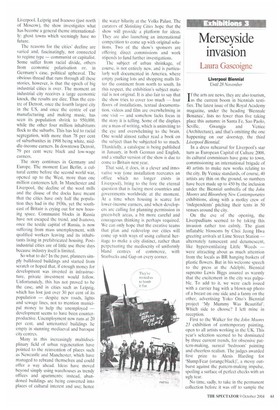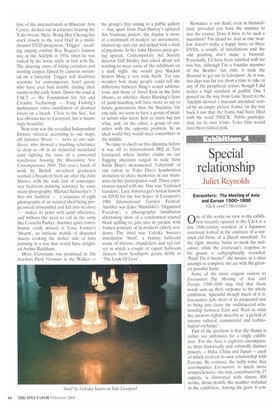Merseyside invasion
Laura Gascoigne
Liverpool Biennial Until 28 November I f the arts are news, they are also tourism, as the current boom in biennials testifies. The latest issue of the Royal Academy magazine, under the heading 'Biennale Bonanza', lists no fewer than five taking place this autumn: in Santa Fe, Sao Paolo, Seville, Gwangju and Venice (Architecture), and that's omitting the one happening on our doorstep, the third Liverpool Biennial.
In a dress rehearsal for Liverpool's star turn as European Capital of Culture 2008, its cultural commissars have gone to town, commissioning an international brigade of 40 artists to make new works relating to the city. By Venice standards, of course, 40 artists are thin on the ground, so numbers have been made up to 450 by the inclusion under the Biennial umbrella of the John Moores and Bloomberg New Contemporaries exhibitions, along with a motley crew of 'independents' pitching their tents in 50 venues around the city.
On the eve of the opening, the Liverpudlians seemed to be taking this invasion rather too calmly. The giant inflatable blossoms by Choi Jeong Hwa greeting arrivals at Lime Street Station — alternately tumescent and detumescent, like hyperventilating Little Weeds — were attracting about as much attention from the locals as BR hanging baskets of plastic flowers. But in his welcome speech to the press at the Adelphi, Biennial supremo Lewis Biggs assured us warmly that the excitement in the city was palpable. To add to it, we were each issued with a carrier bag with a blown-up photo of a breast on one side and a fanny on the other, advertising Yoko Ono's Biennial project 'My Mummy Was Beautiful'. Which side to choose? I left mine in reception.
First to the Walker for the John Moores 23 exhibition of contemporary painting, open to all artists working in the UK. This year's selection seemed to be dominated by three current trends, for obsessive pattern-making, surreal 'bedroom' painting and cheerless realism. The judges awarded first prize to Alexis Harding for `Slump/Fear (orange/black)', a messy outburst against the pattern-making impulse, spoiling a surface of perfect checks with an ugly tear.
No time, sadly, to take in the permanent collection before it was off to sample the first of the internationals at Bluecoat Arts Centre, decked out in a banner bearing the Yoko breast. Here, Wong Hoy Cheong has stuck closely to the local brief in a multichannel DVD projection, 'Trigger', recalling singing cowboy Roy Rogers's famous stay at the Adelphi in 1954, when he was visited by his horse while in bed with flu. The dizzying views of tilting corridors and swirling carpets filmed by cameras mounted on a latterday Trigger will doubtless resonate for contemporary hotel guests who have ever had trouble finding their rooms in the early hours. Down the road at FACT — the Foundation for Art and Creative Technology — Yang Fudong's multiscreen video installation of doomed lovers on a beach, 'Close to the Sea', has less obvious ties to Liverpool, but is hauntingly beautiful.
Next stop was the so-called Independent District situated, according to our maps, off Jamaica Street — news to our taxidriver, who showed a touching reluctance to drop us off in an industrial wasteland until sighting the oasis of a converted warehouse housing the Bloomberg New Contemporaries 2004. This year's batch of work by British art-school graduates seemed a breath of fresh air after the John Moores, with the stale loaf of contemporary bedroom painting leavened by some sharp photography. Michael Sailstorfer's '3 Ster mit Ausblick' — a sequence of eight photographs of an isolated shed being progressively dismantled and fed into its stove — makes its point with quiet efficiency, and without the need to call in the army like Cornelia Parker. Another quiet contribution, easily missed, is Tessa Farmer's 'Swarm', an intricate mobile of dissected insects evoking the darker side of fairy painting in a way that would have delighted Arthur Rackham.
More Victoriana was promised in The Stockists Punk Victorian at the Walker — the group's first outing in a public gallery — but, apart from Paul Harvey's updated Art Nouveau posters, the display is more of a mishmash of modern art movements, chewed up, spat out and spiked with a dash of psychosis. In her John Moores prize-giving speech, Contemporary Art Society director Gill Hedley had joked about not wanting to meet some of the exhibitors on a dark night: she would give Stuckist Sexton Ming a very wide berth. Yet one wonders how many people could tell the difference between Ming's sexual sublimations and those of Ansel Krut in the John Moores, or whether Alexis Harding's feats of paint-handling will have more to say to future generations than the Stuckists. On one side, we seem to have a group of insider artists who know how to paint but not what, and, on the other, a group of outsiders with the opposite problem. In an ideal world they would meet somewhere in the middle.
No time to dwell on this dilemma before it was off to International HQ at Tate Liverpool, where further claims on our flagging attention ranged in scale from Satch Hoyt's monumental 'Labyrinth' of raw cotton to Yoko Ono's handwritten invitation to share memories of our mummies on her participation wall. Three experiences stayed with me. One was 'Enclosed Gardens', Lara Almarcegui's lyrical lament on DVD for the lost hopes of Liverpool's 1984 International Garden Festival. Another was Esko MannikkO's 'Organised Freedom', a photographic installation alternating shots of a condemned council block spilling its guts into its garden, with framed portraits of its resilient elderly residents. The third was Valeska Soares's installation `Swirl', a fantasy ballroom made of mirrors, chandeliers and red velvet in which a couple of expert ballroom dancers from Southport gyrate deftly to 'The Look Of Love'. Romance is not dead, even in biennialland, provided you have the stamina to stay the course. Does it have to be such a marathon? I'm afraid so. Just as one swallow doesn't make a happy hour, so three DVDs, a couple of installations and the odd painting don't make a biennial. Personally, I'd have been satisfied with far less but, although I'm a founder member of the Beatles' fan club, it took the Biennial to get me to Liverpool. As it was, two days was far too short a time to take in any of the peripheral action, though I did notice a high standard of graffiti. One I passed on the way from Lime Street to the Adelphi showed a museum attendant seated by an empty picture frame; on the way back I saw that the frame had been filled with the word 'PRICK'. Public participation, on its own terms: Yoko Ono would have been tickled pink.



















































































































 Previous page
Previous page